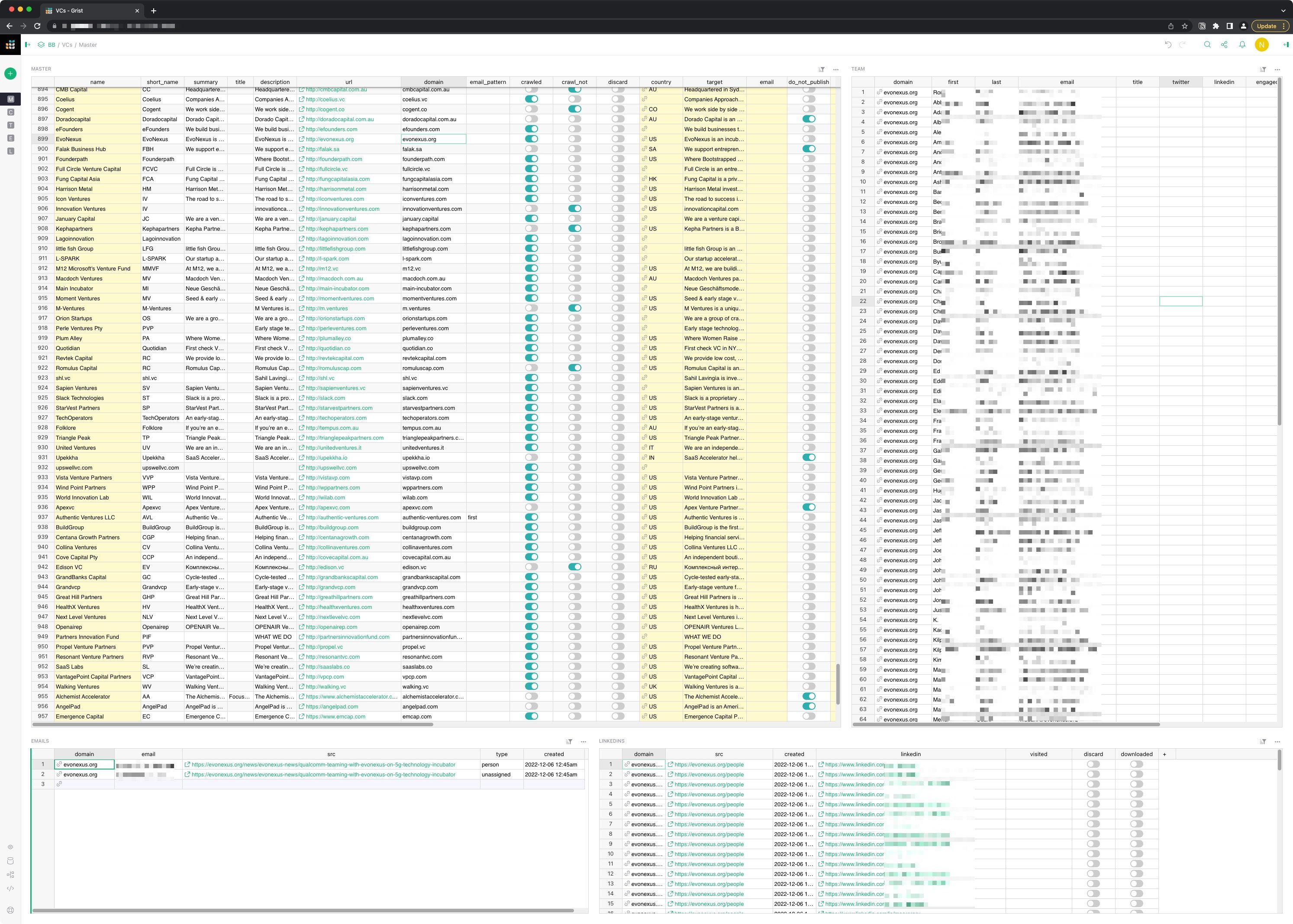- Submission
- What is your company’s name? What kind of work does it do?
- What is your title, role, and responsibilities?
- What problem were you trying to solve when you set out looking for a tool like Grist?
- What tools were you using? What was the former process and its pain points?
- How did you find Grist? What made you decide on Grist?
- How are you using Grist now?
- Do you work in a team, and if so, how many team members?
- How has Grist affected you/your team's workflow and data management?
19 Dec 2022
Grist reached out a few weeks ago to ask if I'd be willing to do a case study.

I love the product and have been using it for more than a year now (Grist | The Evolution of Spreadsheets), so I was happy to oblige.
Only now getting to do this write-up, but here it is:
Submission
What is your company’s name? What kind of work does it do?
I am now freelancing in B2B Sales, helping US B2B SaaS companies expand their business in Europe: https://BtoBSales.EU
I was previously VP Sales & MD EMEA (2x) of VC-backed US & Australian SaaS startups which IPO'ed, and then bootstrapped 2x platform/SaaS startups which were acquired.
What is your title, role, and responsibilities?
I'm the principal at BtoBSales.EU and sole employee - so I do everything, relying on freelancers for specific tasks (outsourcing data tasks is one of the many uses I have for Grist).
What problem were you trying to solve when you set out looking for a tool like Grist?
Mainly lightweight data management combined with automations.
What tools were you using? What was the former process and its pain points?
A few years ago, the startup we were building back then (in the private jet industry) combined both a platform compoment with a lot of data, and back-office automations for our members (eg automated invoice processing).
I couldn't find a CTO for our bootstrapped startup.
So I decided to start learning programming (quite late in life, aged 37), and build a platform and automations behind, with a combination of code, no-code and freelancers.
I chose to learn Python as it was the most popular language for automation, and a pillar of AI which I had also intended to learn.
For the first few years, when managing data that did not warrant spinning up a whole database on AWS (most of my needs), I used Excel files.
I became quite proficient with manipulating Excel using Python, but it was still a pain to manage the data, files and lack of sharing.
The visual grid interface is a must for me (I'm visual) but I also wanted something more purpose-built than Excel.
I tried a few solutions, but none really stuck.
How did you find Grist? What made you decide on Grist?
I can't remember how I found Grist - I think it might have been via ProductHunt, or one of the many apps newsletters/Reddits, etc.. I follow.
When I came across Grist, it was a no-brainer to me as it seemed to combine everything I needed:
- Excel-like interface & logic
- Database-like features
- Sharing and collaboration
- Custom views
- Built-in backup & versioning
- most importantly: Python API (and Python logic underpinning everything actually)
The one limitation I came across is the "document" size (equivalent to an Excel file, with tabs).
For the few cases where I need a larger database, but still don't want to spin up a cloud database for it, I have started using local SQLite database files.
How are you using Grist now?
I have now many workspaces, and documents within each.
I separate workspaces as follows:
- one for each of my clients
- one for my own company (https://devyer-ventures.com/)
- one for my trading activities in B2B Sales (https://btobsales.eu/)
- one for each of my personal projects (eg https://indexall.io/)
- one for my personal site (https://notes.nicolasdeville.com/)
I have many Python scripts & automations that will run with Grist as the data backbone.
My use cases are:
- mainly: for lightweight databases, and automation management.
- lightweight CRMs
- timesheet management with freelancers
For example, out of frustration with the existing emailing automation tools, I built my own (just based on Python scripts).
Grist is where I will have leads lists, along with the email campaigns management.
You can see more here: https://notes.nicolasdeville.com/projects/mailingee/
I'm also a big fan of lists in general 🤷🏻♂️
For example, I'm putting together now the following lists, all using Grist as the data backbone:
- VCs in SaaS & AI (published at https://btobsales.eu/resources/directory-vcs)
- Recruiters in Europe with a focus on Sales & Executives (published at https://btobsales.eu/resources/directory-recruiters)
- virtual & hybrid events companies (published at https://btobsales.eu/resources/directory-virtual-events-providers)
All these lists start with some data import to Grist using public sources.
Data cleaning & enrichment is done in Grist, using Python scripts.
I will then keep adding to these lists in batches (if I come across a full list), or one by one - I have various scripts and keyboard shortcuts to add new entries quickly to Grist.
I really like that I can configure my view, adding multiple tables as "widgets", to be able to see all records associated with a given master record.
Here for example is a view combining 4 tables, with 3 of them being "widgets" (the 1st one is the master record upon which selection is based):

I also use Grist as a custom-built lightweight CRM for my own activities with my clients - each seggregated in its own workspace.
This allows me to control the data better across clients, from which I can generate custom reports and automations (including updating the client's CRM with the data they want to see).
On the personal front, I manage for example my top movies list.
See here for my project notes: https://notes.nicolasdeville.com/projects/1000-movies/
and here for the published list: https://notes.nicolasdeville.com/movies/1000/
I do the same with books, apps and links I want to keep track of - all of which I publish using Python scripts fetching data from Grist and generating the needed HTML files.
I don't do much outside of database-like use cases, but I will use Grist occasionally for other things, like for example timesheet management with freelancers.
Do you work in a team, and if so, how many team members?
Only with freelancers.
As mentioned, this is a good use case also for Grist: I can share a document with a freelancer, and they can work on it, without having to give them access to the whole Grist account.
How has Grist affected you/your team's workflow and data management?
Grist has become a staple of my data management & automation workflows.
I keep an open note here if anyone is interested: Grist | The Evolution of Spreadsheets
